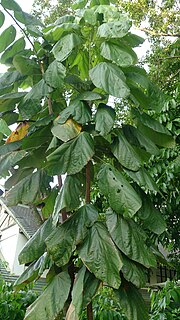
Sorghum is a genus of flowering plants in the grass family Poaceae, which includes about 25 species. Some of these species have grown as cereals for human consumption and some in pastures for animals. One species, Sorghum bicolor, was originally domesticated in Africa and has since spread throughout the globe. Seventeen of the 25 species are native to Australia, with the range of some extending to Africa, Asia, Mesoamerica, and certain islands in the Indian and Pacific Oceans. One species is grown for grain, while many others are used as fodder plants, either cultivated in warm climates worldwide or naturalized in pasture lands. Sorghum is in the subfamily Panicoideae and the tribe Andropogoneae.

A bicolor cat or piebald cat is a cat with white fur combined with fur of some other color, for example black or tabby. There are various patterns of bicolor cat. These range from Turkish Van pattern through to solid color with a throat locket.

Quercus bicolor, the swamp white oak, is a North American species of medium-sized trees in the beech family. It is a common element of America's north central and northeastern mixed forests. It can survive in a variety of habitats. It forms hybrids with bur oak where they occur together in the wild.

Sorghum bicolor, commonly called sorghum and also known as great millet, durra, jowari / jowar, or milo, is a grass species cultivated for its grain, which is used for food for humans, animal feed, and ethanol production. Sorghum originated in Africa, and is now cultivated widely in tropical and subtropical regions. Sorghum is the world's fifth-most important cereal crop after rice, wheat, maize, and barley, with 59.34 million metric tons of annual global production in 2018. S. bicolor is typically an annual, but some cultivars are perennial. It grows in clumps that may reach over 4 m high. The grain is small, ranging from 2 to 4 mm in diameter. Sweet sorghums are sorghum cultivars that are primarily grown for forage, syrup production, and ethanol; they are taller than those grown for grain.

The bicolored roundleaf bat is a species of bat in the family Hipposideridae found in Indonesia, Malaysia, the Philippines, Thailand, and Timor-Leste. This bat inhabits caves, rock crevices and tunnels among lowland forests. They roost in large numbers and consumer mostly small winged insects. Their navigation and hunting skills come from the use of echolocation. Its leafnose is used to release ultrasonic shouts to distinguish its surroundings. Echolocation is also used to distinguish other species based on their wingbeat and size. The habitat of this bat decides the color of its fur. Bleaching fumes of a cave environment will cause an orange colored fur. Those who inhabit a well-ventilated roost will be a light brown color.

Theobroma bicolor, known commonly as the mocambo tree, jaguar tree, balamte, or pataxte, among various other common names, is a tree in the genus Theobroma, which also contains the better-known Theobroma cacao. It is found in Central and South America, including stretches of the Amazon rainforest in Brazil, Colombia, Ecuador, and Peru.

Eunidiini is a tribe of longhorn beetles of the subfamily Lamiinae. It was described by Téocchi et al. in 2010.

Eunidia is a genus of longhorn beetles of the subfamily Lamiinae.
Eunidia fallaciosa is a species of beetle in the family Cerambycidae. It was described by Stephan von Breuning in 1939. It is known from Somalia.
Eunidia fuscostictica is a species of beetle in the family Cerambycidae. It was described by Stephan von Breuning in 1939.
Eunidia rufescens is a species of beetle in the family Cerambycidae. It was described by Breuning in 1939. It is known from Mozambique, Kenya, and South Africa. It contains the varietas Eunidia rufescens var. holatripes.
Eunidia spilotoides is a species of beetle in the family Cerambycidae. It was described by Stephan von Breuning in 1939.
Eunidia kivuana is a species of beetle in the family Cerambycidae. It was described by Stephan von Breuning in 1952.
Eunidia parastrigata is a species of beetle in the family Cerambycidae. It was described by Stephan von Breuning in 1978.
Eunidia kristenseni is a species of beetle in the family Cerambycidae. It was described by Per Olof Christopher Aurivillius in 1911. It is known from tropical Africa.
Eunidia batesi is a species of beetle in the family Cerambycidae. It was described by Olliff in 1889.
Eunidia caffra is a species of beetle in the family Cerambycidae. It was described by Fahraeus in 1872.
Eunidia camerunica is a species of beetle in the family Cerambycidae. It was described by Téocchi, Sudre and Jiroux in 2010.
Eunidia strigata is a species of beetle in the family Cerambycidae. It was described by Fahraeus in 1872. It contains the varietas Eunidia strigata var. damarensis.

Eunidia thomseni is a species of beetle in the family Cerambycidae. It was described by William Lucas Distant in 1898. It is known from Tanzania, Cameroon, Chad, Niger, Ethiopia, Senegal, Mozambique, Botswana, Namibia, Saudi Arabia, the Central African Republic, Somalia, Uganda, South Africa, Yemen, Kenya, and Zimbabwe.







